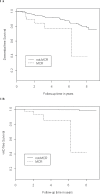Motoric cognitive risk syndrome and the risk of dementia
- PMID: 22987797
- PMCID: PMC3593614
- DOI: 10.1093/gerona/gls191
Motoric cognitive risk syndrome and the risk of dementia
Abstract
Background: Despite growing evidence of links between gait and cognition in aging, cognitive risk assessments that incorporate motoric signs have not been examined. We sought to validate a new Motoric Cognitive Risk (MCR) syndrome to identify individuals at high risk of developing dementia.
Methods: We evaluated 997 community residing individuals aged 70 and older participating in the Einstein Aging Study over a median follow-up time of 36.9 months. MCR syndrome was defined as presence of cognitive complaints and slow gait (one standard deviation below age- and sex-specific gait speed means) in nondemented individuals. Cox models were used to evaluate the effect of MCR syndrome on the risk of developing dementia and subtypes.
Results: Fifty-two participants met criteria for MCR syndrome at baseline with a prevalence of 7% (95% CI: 5-9%). Prevalence of MCR increased with age. Participants with MCR were at higher risk of developing dementia (hazard ratio [HR] adjusted for age, sex, and education: 3.27, 95% CI: 1.55-6.90) and vascular dementia (adjusted HR: 12.81, 95% CI: 4.98-32.97). The association of MCR with risk of dementia or vascular dementia remained significant even after accounting for other confounders and diagnostic overlap with "cognitive" mild cognitive impairment syndrome subtypes.
Conclusions: A motor-based MCR syndrome provides a clinical approach to identify individuals at high risk for dementia, especially vascular dementia, to target for further investigations and who may benefit from preventive interventions.
Figures
Comment in
-
Motoriek als onafhankelijke voorspeller van risico op dementie.Tijdschr Gerontol Geriatr. 2014 Sep;45(4):238-9. doi: 10.1007/s12439-014-0081-5. Epub 2014 Jul 22. Tijdschr Gerontol Geriatr. 2014. PMID: 25047963 Dutch. No abstract available.
References
-
- Rosano C, Brach J, Longstreth Jr WT, Newman AB. Quantitative measures of gait characteristics indicate prevalence of underlying subclinical structural brain abnormalities in high-functioning older adults. Neuroepidemiology. 2006; 26: 52–60 - PubMed
-
- Verghese J, Derby C, Katz MJ, Lipton RB. High risk neurological gait syndrome and vascular dementia. J Neural Transm. 2007; 114: 1249–1252 - PubMed
-
- Verghese J, Lipton RB, Hall CB, Kuslansky G, Katz MJ, Buschke H. Abnormality of gait as a predictor of non-Alzheimer’s dementia. N Engl J Med. 2002; 347: 1761–1768 - PubMed
-
- McGinn AP, Kaplan RC, Verghese J, et al. Walking speed and risk of incident ischemic stroke among postmenopausal women. Stroke. 2008; 39: 1233–1239 - PubMed
Publication types
MeSH terms
Grants and funding
LinkOut - more resources
Full Text Sources
Other Literature Sources
Medical
Miscellaneous


